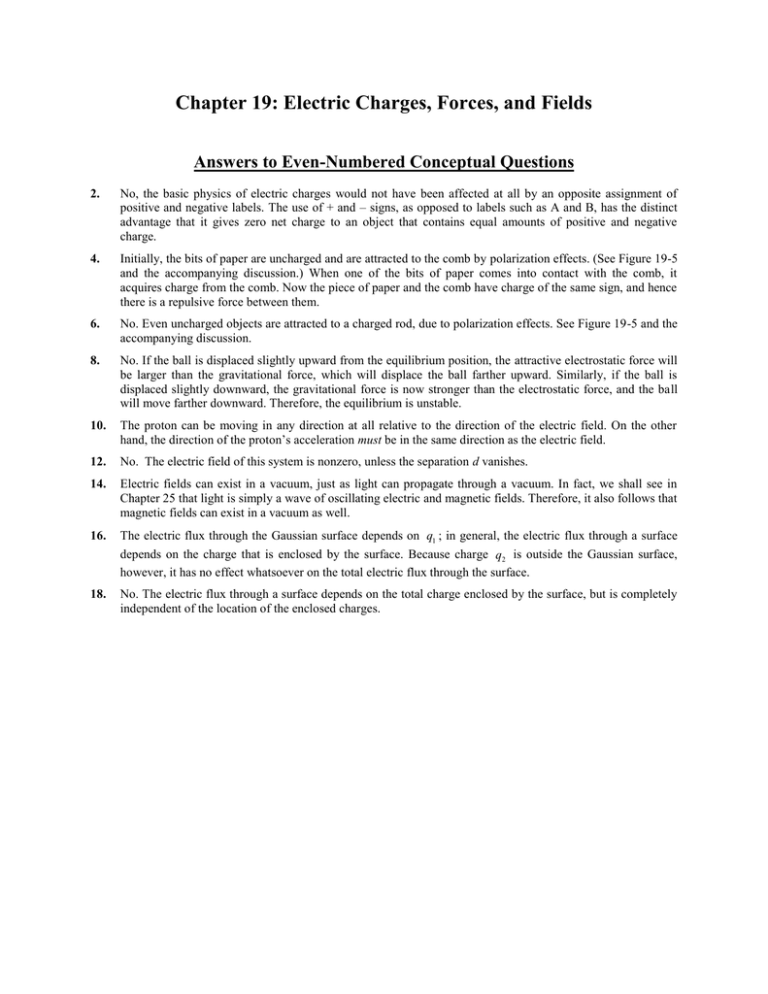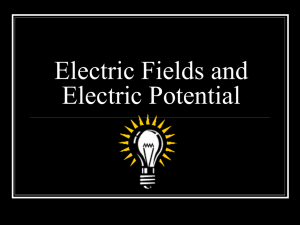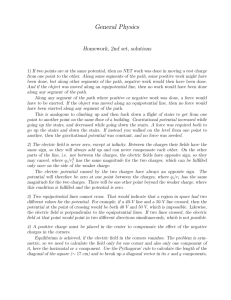Chapter 19: Electric Charges, Forces, and Fields
advertisement

Chapter 19: Electric Charges, Forces, and Fields Answers to Even-Numbered Conceptual Questions 2. No, the basic physics of electric charges would not have been affected at all by an opposite assignment of positive and negative labels. The use of + and – signs, as opposed to labels such as A and B, has the distinct advantage that it gives zero net charge to an object that contains equal amounts of positive and negative charge. 4. Initially, the bits of paper are uncharged and are attracted to the comb by polarization effects. (See Figure 19-5 and the accompanying discussion.) When one of the bits of paper comes into contact with the comb, it acquires charge from the comb. Now the piece of paper and the comb have charge of the same sign, and hence there is a repulsive force between them. 6. No. Even uncharged objects are attracted to a charged rod, due to polarization effects. See Figure 19-5 and the accompanying discussion. 8. No. If the ball is displaced slightly upward from the equilibrium position, the attractive electrostatic force will be larger than the gravitational force, which will displace the ball farther upward. Similarly, if the ball is displaced slightly downward, the gravitational force is now stronger than the electrostatic force, and the ball will move farther downward. Therefore, the equilibrium is unstable. 10. The proton can be moving in any direction at all relative to the direction of the electric field. On the other hand, the direction of the proton’s acceleration must be in the same direction as the electric field. 12. No. The electric field of this system is nonzero, unless the separation d vanishes. 14. Electric fields can exist in a vacuum, just as light can propagate through a vacuum. In fact, we shall see in Chapter 25 that light is simply a wave of oscillating electric and magnetic fields. Therefore, it also follows that magnetic fields can exist in a vacuum as well. 16. The electric flux through the Gaussian surface depends on q1 ; in general, the electric flux through a surface depends on the charge that is enclosed by the surface. Because charge q2 is outside the Gaussian surface, however, it has no effect whatsoever on the total electric flux through the surface. 18. No. The electric flux through a surface depends on the total charge enclosed by the surface, but is completely independent of the location of the enclosed charges. Chapter 20: Electric Potential and Electric Potential Energy Answers to Even-Numbered Conceptual Questions 2. The two like charges, if released, will move away from one another to infinite separation, converting the positive electric potential energy into kinetic energy. The two unlike charges, however, attract one another – if their separation is to be increased, a positive work must be done. In fact, the minimum amount of work that must be done to create an infinite separation between the charges is equal to the magnitude of the original negative electric potential energy. 4. An equipotential surface must always cross an electric field line at right angles. Therefore, the equipotential surface at point 1 is concave to the right, the equipotential surface at point 2 is vertical, and the equipotential surface at point 3 is concave to the left. 6. The electric field is either zero on this surface, or it is nonzero and perpendicular to the surface. If the electric field had a nonzero component parallel to the surface, the electric potential would decrease as one moved in the direction of the parallel component. 8. Not necessarily. The electric potential energy of the two charges would be the same only if the charges are also equal. In general, the electric potential energy is the charge times the electric potential. Therefore, just having equal potentials does not guarantee equal potential energy. 10. Capacitors store electrical energy in the form of an electric field between their plates. This stored energy can remain in a capacitor even when a device such as a television is turned off. Accidentally touching the terminals can cause the sudden and potentially dangerous release of this energy. 12. A capacitor stores charge of opposite sign in two different locations—though, of course, the net charge is zero. We can think of a capacitor, then, as storing a “charge separation,” along with the energy required to cause the charge separation in the first place. Chapter 21: Electric Current and Direct-Current Circuits Answers to Even-Numbered Conceptual Questions 2. No. An electric current is produced when a net charge moves. If your body is electrically neutral, no current is produced when you walk. 4. Yes. There is a net charge on the comb, and by moving it from one place to another you have created an electric current. 6. Car headlights are wired in parallel, as we can tell by the fact that some cars have only one working headlight. 8. Yes. Just connect two of these resistors in parallel and you will have an equivalent resistance of R/2. 10. Resistors connected in parallel have the same potential difference across their terminals. 12. Resistivity is an intrinsic property of a particular substance. In this sense it is similar to density, which has a particular value for each particular substance. Resistance, however, is a property associated with a given resistor. For example, the resistance of a given wire can be large because its resistivity is large, or because it is long. Similarly, the weight of a ball can be large because its density is large, or because it has a large radius. 14. Magnetic resonance imaging (MRI) machines would definitely benefit from room-temperature superconductivity. As it is, they must cool their magnets to low temperature. Similarly, electrical power transmission would benefit if the resistance of the wires could be eliminated. On the other hand, a toaster or an electric oven requires resistance to do its job; superconductivity would not be a help. 16. Capacitors connected in series all have the same magnitude of charge on their plates. This is illustrated in Figure 21-18 (a). 18. The light shines brightest immediately after the switch is closed. With time, the intensity of the light diminishes. Eventually, the light stops glowing altogether.






